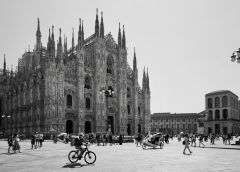
Why ‘Milan Chic’ Is An Exciting Insider Travel Favorite
[ad_1]
Milan Cathedral — gargantuan and gorgeous.
Urban Italy unfurls a wealth of spectacular travel experiences. The rich historical sites of Rome, founded in 753 BC. The artistic exuberance of Florence. The epic grandeur of romantic sea-faring Venice with its Grand Canal and more than 110 islands and 400 bridges. The architecture, gastronomy and heritage of Palermo in Sicily, a crossroad of civilizations for millennia. These very popular cities draw the most interest from travelers to Italy. Yet you’d be amply rewarded to widen your attention to include another distinctive gem: Milan — a world capital of high-design, fashion excellence, innovative aesthetics, bounteous creativity and cultural dynamism. Determined, industrious and forward-thinking, Milan is magnificent! A stunning new book points the way: Milan Chic ($95; produced by Assouline Publishing), written by accomplished journalist and author Massimo Nava. It is substantial (10 by 13 inches), hefty (more than 6 pounds) and silk-covered, containing 296 thick glossy pages, many of which feature the work of esteemed photographer Oberto Gili.
.
Milan Chic illuminates notable public places as well as secluded havens. “A short walk from the fashion district, where sophisticated women carry shiny shopping bags bearing famous labels, you can see a line of visitors from Japan, America and Europe,” Nava says. “They are in a quiet pedestrian square, just in front of a narrow door, awaiting entry, and can gain access only if they have booked ahead. They don’t waste time. In this case, time has the face of Santa Maria delle Grazie, a building of warm reddish brick. In the refectory of this beautiful Gothic-Renaissance church is one of the most famous masterpieces in the world, Leonardo da Vinci’s Last Supperwell known, too, thanks to Dan Brown’s The Da Vinci Code. But not many people know that the mural was painted and preserved in Milan…. Standing in front of the Last Supper starts you on a spiritual journey into the secret story of the city.”
.
Here is a sampling of Milan Chic’s words and images to stir your wanderlust. Consider curling up with the book itself, embarking on an imaginative trip abroad while perhaps sipping an espresso or Campari aperitif at home. At your fingertips, there is much of impeccably dressed Milan to explore, such as the lovely old quarter of Brera, with “its colorful, narrow walking streets and palaces…a district where fashion and nightlife combine, a classic meeting place after a movie or the theater,” recommends Nava. Note Milan’s greenery (such as Stefano Boeri’s Vertical Forest), favorite culinary hot spots, storied mansions, glamorous stores, galleries, apparel houses and artisanal workshops. Most of all, understand that Milan’s remarkable essence is best embraced within its hidden courtyards and building interiors. Milan Chic reveals generous peeks behind those closed doors.
Art installation from Milan Design City.
Peer, as well, at photos of some of the city’s sought-after, gifted personalities: architects, artists, designers, restaurateurs, scientists and other visionaries. Their passion for this Northern Italian metro-magnet is compelling; quotes are shared below. Dare to be enticed by Milan’s intoxicating spell.
Attendee at Milan’s Armani Fashion Show.
“Milan excitement, seduction and work keep the heart and mind alive,” muses artist Sofia Cacciapaglia. “Milan is characterized by its two rings of walls that enclose it like a crown. In Milan everyone walks fast, people run here and there… Time flies…. The pace of the city is quick and agile…. [This is a city] of ‘organized’ creativity and of those who love elegance in all things.”
Right: Coat-of-arms mosaic at Galleria Vittorio Emanuele II.
“Milan is not classifiable because it is so special,” opines writer Daniela Morera. “Synchronized with the present, polite and respectful, it is a work in progress without end, but also romantic with gardens discreetly hidden…. It is not a silhouette but a real body full of nuances, filled with current culture, style…and contemporary art foundations like Prada and HangarBicocca [that are] unrivaled in the world. Even our street vendors display fruits and vegetables in a glorious manner.”
Left: Jewelry designer Nicolò Villa. Right: Artist Alessandra Orsi and industrial designer Francesco … [+]
“In Milan…everything is on a human scale. I ride a scooter and in thirty minutes I arrive from one end of the city to another,” explains designer Stefano Giovannoni. “At the same time, Milan is a hybrid city where diversity and international convergence, in a limited area, make intercultural exchange easier. It’s an open and welcoming city for newcomers, very livable for young minds deserving success in the world.”
Artist Luca Pignatelli in his studio with wife, Maria.
“I love the way it sounds: MI-LA-NO, three perfect syllables…. Walking through the Milanese streets, squares, courtyards and neighborhoods, all different from one another…every day is a surprise, a movie en plein air! …We are the reflection of Greek culture, of the Roman emperors, of an incomparable aesthetic thinking,” says artist Luca Pignatelli.
Home of fashion designer Romeo Gigli.
“Milan has always been a city associated with the avant-garde, at the cutting-edge of progress, the place where trends arrive first, but which also has huge respect for the past — not a museum-style past, locked up in glass cases — but one that you can still live in,” enthuses architect Mario Abruzzese.
Left: Stone bas-reliefs outside of the historic Roman Theater. Right: Pegasus sculpture on the … [+]
“Milan is a city traditionally open to creative people from all over the world who want to work in a positive, hardworking atmosphere. I was born in Rome, but Milan gave me my home, my own family and the opportunity to achieve my dreams as an artisan designer in a friendly and professional environment,” says furniture designer Osanna Visconti. “Milan is a city of secret beauty, which is worth discovering, where art, music, design, fashion and architecture all melt together in an ideal energy.”
Left: Casa Manzoni. Right: Mosaic of Samson and Delilah on wall of Antica Barbieria Colla.
“I absolutely must say thanks to one of the most amazing cities in the world. Milan has welcomed me, opened its doors and invited me into a truly beautiful dream, and none of it would have been possible without the help of my marvelous Milanese friends and mentors,” says artist Hugh Findletar. “These special people have guided me along the road towards elegance and helped me discover the true meaning of chic! And that’s the essence of my Milano.”
Left: Staircase in Museo Poldi Pezzoli. Right: Marble sculpture of Greek God Zeus at Museo Civico … [+]
“In Milan you think of La Scala, the great palazzos, the ironwork of the gates, the secret gardens, Gio Ponti’s mosaics, Lake Como — in short, everything that is theatrical, creative and extravagant about the city,” declares designer Bruno Moinard.
The iron-and-glass dome of Galleria Vittorio Emanuele II — Italy’s oldest active shopping gallery.
“Milan is very different from all other Italian cities: a place where the balance between the beautiful and ugly, the old and new has become an identity over time. Its ability to preserve hidden places and experiences, not very visible or known, is a source of continuous discovery,” explain architect/artist Vincenzo De Cotiis and Claudia Rose De Cotiis, CEO/co-founder of Vincenzo De Cotiis Architecture and Gallery. “We love Milan for this very reason…. [It is] a powerful center of contemporary regeneration.”
For more info about traveling to Italy, go to the Italian National Tourist Board North America.
[ad_2]
Source link


